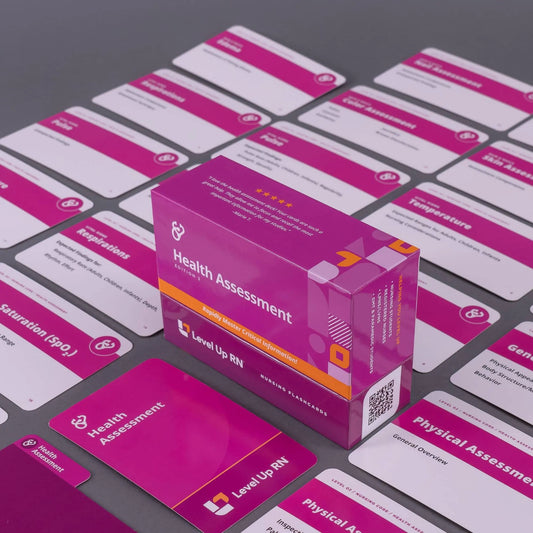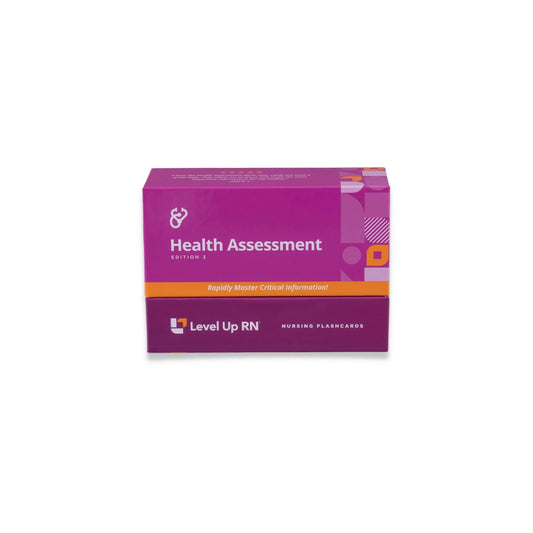In this video and article, we explain how to assess your patient's blood pressure, some specific considerations for the assessment of blood pressure, and the expected blood pressure ranges and the levels of hypertension for adults.
This series follows along with our Health Assessment - Nursing Flashcards which are intended to help RN and PN nursing students study for nursing school exams, including the ATI, HESI, and NCLEX.
 When you see this Cool Chicken, that indicates one of Cathy's silly mnemonics to help you remember. The Cool Chicken hints in these articles are just a taste of what's available across our Level Up RN Flashcards for nursing students!
When you see this Cool Chicken, that indicates one of Cathy's silly mnemonics to help you remember. The Cool Chicken hints in these articles are just a taste of what's available across our Level Up RN Flashcards for nursing students!
Systolic vs. diastolic blood pressure
When you take a blood pressure reading, you are getting two numbers — the systolic blood pressure and the diastolic blood pressure. Systolic blood pressure is the amount of pressure generated against the arterial walls during left ventricular systole (contraction of the heart). Diastolic blood pressure is the amount of pressure generated against the arterial walls during left ventricular diastole (relaxation of the heart).
When you are reading a blood pressure value, systolic is the number on the top and diastolic is the number on the bottom.
 Systolic is in the Sky (top number). Diastolic is in the Dirt (bottom number).
Systolic is in the Sky (top number). Diastolic is in the Dirt (bottom number).
It may also help to remember your fractions—the numerator is on top, while the denominator is on the bottom. Diastolic and denominator are both on the bottom.
Choosing the appropriate arm to take blood pressure
The first step in taking blood pressure is to choose the appropriate arm on which to obtain the reading. Here are some reasons you would NOT choose a specific arm:
- Do not take blood pressure on an arm that has a running IV infusion. Taking blood pressure on this arm would occlude the infusion, and cause pain.
- Do not take blood pressure on an arm that has a PICC line (peripherally inserted central catheter). Taking blood pressure on this arm could cause damage or dislodge the catheter.
- Do not take blood pressure on an arm that has an AV fistula (arteriovenous fistula), as this is a surgically created graft site where a patient may receive hemodialysis. Usually, a patient will know to give you this instruction. They might say "you can't take a blood pressure in this arm because I have an AV fistula." This is important teaching that is always given to patients who have an AV fistula. But you also need to know too. And once you've seen it, you will probably be able to recognize it in the future—but always confirm with the patient.
- Do not take blood pressure on an arm that is on the same side that the patient has had a mastectomy. In a mastectomy, the nearby lymph nodes may also be removed or damaged, and a blood pressure cuff has the potential to cause lymphedema. If a patient has undergone a double mastectomy or there is a reason you can't use the other arm, blood pressure can be taken from the thigh.
Blood pressure positioning
When you take a blood pressure reading, the patient should be in a seated, relaxed position with their legs uncrossed and their arm at the level of their heart. Their arm should be supported, so the muscles are not straining or tense.
Blood pressure cuffs
When taking blood pressure, it is very important to select a cuff that is the appropriate size for your patient. The blood pressure cuff width should be approximately 40% of the arm circumference. The bladder of the cuff should surround 80% of the arm circumference.
A blood pressure cuff that is too small will cause a falsely high reading. A blood pressure cuff that is too large will cause a falsely low reading.
 If the cuff is too Large, you will get a falsely Low reading. If it is too Small, you will get a Sky high reading.
If the cuff is too Large, you will get a falsely Low reading. If it is too Small, you will get a Sky high reading.
Taking a blood pressure reading
- Apply the (size-appropriate) blood pressure cuff snugly around the (properly positioned) patient's (appropriate) arm, 1" above the brachial artery.
- Palpate the radial pulse while inflating the cuff until the pulse disappears.
- Continue inflating the cuff an additional 30 mmHg.
- Place the stethoscope over the brachial artery while slowly and steadily releasing the air from the cuff. Note the mmHg reading at the first sound (this is systolic) and when the sound disappears (this is diastolic).
A "two-step" blood pressure reading that you may need to learn in nursing school involves an additional step
In the two-step method, you inflate the cuff on the patient's arm twice. Once to get to your +30 number, and again after several minutes to take the actual reading. Which method you use in nursing school will depend on what your instructors teach.
- Apply the (size-appropriate) blood pressure cuff snugly around the (properly positioned) patient's (appropriate) arm, 1" above the brachial artery.
- Palpate the radial pulse while inflating the cuff until the pulse disappears.
- Continue inflating the cuff an additional 30 mmHg. Note this number (e.g., if the pulse disappeared at 120, and you continued inflating up to 150, you would note 150.)
- Let the cuff deflate, wait several minutes, and then inflate the cuff again to your +30 number (150 in the example above)
- Place the stethoscope over the brachial artery while slowly and steadily releasing the air from the cuff. Note the mmHg reading at the first sound (this is systolic) and when the sound disappears (this is diastolic).
Falsely high blood pressure
These are factors that can make a blood pressure reading falsely high:
- If the patient is talking
- If the patient's legs are crossed
- If the patient's arm is not supported
- If the blood pressure cuff is too tight
Falsely low blood pressure
These are factors that can make a blood pressure reading falsely low:
- If the patient's arm is above their heart
- If the blood pressure cuff is too loose
Blood pressure expected ranges
Expected blood pressure ranges for adults, children, and infants are as follows:
Adults
Systolic blood pressure under 120 mmHg and diastolic blood pressure under 80 mmHg.
Children
Systolic blood pressure 90 - 110 mmHg, diastolic blood pressure 55 - 75 mmHg.
Infants
Systolic blood pressure 65 - 90 mmHg, diastolic blood pressure 45 - 65 mmHg.
Blood pressure - levels of hypertension
Levels of hypertension can be categorized into elevated blood pressure, stage 1 hypertension, stage 2 hypertension, or a hypertensive crisis.
Elevated
Systolic blood pressure 120 - 129 mmHg and diastolic blood pressure less than 80 mmHg.
Stage 1 Hypertension
Systolic blood pressure 130 - 139 mmHg, or diastolic blood pressure 80 - 89 mmHg.
Stage 2 Hypertension
Systolic blood pressure 140 mmHg or higher, or diastolic blood pressure 90 mmHg or higher.
Hypertensive Crisis
Systolic blood pressure higher than 180 mmHg and/or diastolic blood pressure higher than 120 mmHg.


